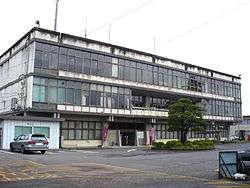Watari, Miyagi
| Watari 亘理町 | |||
|---|---|---|---|
| Town | |||
 Watari Town hall | |||
| |||
 Location of Watari in Miyagi Prefecture | |||
 Watari | |||
| Coordinates: 38°02′16″N 140°51′9.3″E / 38.03778°N 140.852583°ECoordinates: 38°02′16″N 140°51′9.3″E / 38.03778°N 140.852583°E | |||
| Country | Japan | ||
| Region | Tōhoku | ||
| Prefecture | Miyagi | ||
| District | Watari District | ||
| Area | |||
| • Total | 73.60 km2 (28.42 sq mi) | ||
| Population (August 2017) | |||
| • Total | 33,866 | ||
| • Density | 454/km2 (1,180/sq mi) | ||
| Time zone | UTC+9 (Japan Standard Time) | ||
| - Tree | Pinus thunbergii | ||
| - Flower | Camellia sasanqua | ||
| Phone number | 0223-34-0502 | ||
| Address | 7-4 Shimokoji, Watari-chō, Watari-gun, Miyagi-ken 989-2393 | ||
| Website | http://www.town.watari.miyagi.jp/ | ||
Watari (亘理町 Watari-chō) is a town located in Miyagi Prefecture, Japan. As of 31 August 2017, the town had an estimated population of 33,866, and a population density of 454 persons per km² in 12,201 households.[1] The total area of the town is 73.60 square kilometres (28.42 sq mi).
Geography
Watari is located in the Tōhoku region of northern Japan, in the southeastern Miyagi Prefecture, bordered by the Pacific Ocean to the east. The Abukuma River fows through the town, forming its western border. Watari has a humid climate (Köppen climate classification Cfa) characterized by mild summers and cold winters. The average annual temperature in Watari is 12.7 °C. The average annual rainfall is 1249 mm with September as the wettest month. The temperatures are highest on average in August, at around 24.9 °C, and lowest in January, at around 1.7 °C.[2]
Neighboring municipalities
Demographics
Per Japanese census data,[3] the population of Watari has steadily increased over the past 40 years.
| Census Year | Population |
|---|---|
| 1970 | 25,141 |
| 1980 | 27,822 |
| 1990 | 30,301 |
| 2000 | 34,770 |
| 2010 | 34,854 |
History
The area of present-day Watari was part of ancient Mutsu Province, and the place name of “Watari” appears in the Shoku Nihongi chronicles dated 718 AD. It was part of the holdings of Sendai Domain under the Edo period Tokugawa shogunate.
Watari Town was established on April 1, 1889 with the establishment of the post-Meiji restoration modern municipalities system. It merged with the neighboring town of Arahama and villages of Yoshida and Õkuma on February 1, 1955.
Watari was severely damaged by a tsunami caused by an earthquake on 11 March 2011.[4] Hundreds of people were stranded in a school but were airlifted from the roof by Japanese military helicopters.[5] The tsunami covered 47% of the town’s area and 305 residents were reported killed or missing.
Economy
The economy of Watari is largely based on agriculture (strawberries) and commercial fishing and fish processing.
Education
Watari has six public elementary schools and four public middle schools operated by the town government, and one public high school operated by the Miyagi Prefectural Board of Education.
Transportation
Railway
- JR East - Jōban Line
- Hamayoshida - Watari - Ōkuma
Highway
- East Sendai Expressway: Watari IC
- National Route 6
Local attractions
- Sanjūsangendō Government Offices Site, Heian period National Historic Site
References
- ↑ Watari Town official data (in Japanese)
- ↑ Watari climate data
- ↑ Watari population statistics
- ↑ Grossman, Cathy Lynn (15 March 2011). "Japanese look to ancient traditions for strength". USA Today. Retrieved 19 March 2011.
- ↑ Zeitvogel, Karin (19 March 2011). "Japan quake: live report". AFP/Google. Retrieved 19 March 2011.
External links
![]()
- Official Website (in Japanese)
